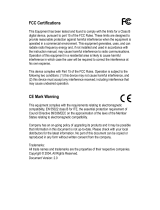
2
Table of Contents
Chapter 1: USB Station 2 at a Glance
Chapter 2: Get Started with DiskStation Manager
Set up USB Station 2 .............................................................................................................................................................. 6
Log in to Synology DiskStation Manager ............................................................................................................................. 6
DiskStation Manager Appearance ...................................................................................................................................... 10
Manage DSM with the Main Menu ..................................................................................................................................... 11
Manage Personal Options ................................................................................................................................................... 13
Chapter 3: Modify System Settings
Change DSM Settings .......................................................................................................................................................... 15
Change Network Settings .................................................................................................................................................... 20
Modify Regional Options ...................................................................................................................................................... 25
Use Energy Saving Features .............................................................................................................................................. 27
Chapter 4: Manage External Disks
Manage External Disks ........................................................................................................................................................ 28
Chapter 5: Access USB Station 2 from the Internet
Use the EZ-Internet Wizard ................................................................................................................................................. 29
Set Up Port Forwarding Rules for Router .......................................................................................................................... 29
Give USB Station 2 a DDNS Hostname ............................................................................................................................ 31
Automatically Block Suspicious Login Attempts ............................................................................................................... 33
Chapter 6: Set Up File Sharing
Enable File Sharing Protocols for All Platforms ................................................................................................................ 35
Manage Users ....................................................................................................................................................................... 37
Manage Shared Folders ....................................................................................................................................................... 41
Chapter 7: Access Files from Anywhere
Access Files within the Intranet........................................................................................................................................... 43
Access Files via WebDAV ................................................................................................................................................... 46
Access Files via FTP ............................................................................................................................................................ 48
Access Files via File Browser .............................................................................................................................................. 50
Access Files via File Station ................................................................................................................................................ 60
Chapter 8: Back Up Data
Back Up Computer Data ...................................................................................................................................................... 61
Chapter 9: Host a Print Server
Set USB Station 2 as Print Server ...................................................................................................................................... 63
Chapter 10: Play Music with Audio Station
Enable Audio Station ............................................................................................................................................................ 69
Choose Audio Source........................................................................................................................................................... 70
Organize Your Music ............................................................................................................................................................ 72
Play Music .............................................................................................................................................................................. 75





















